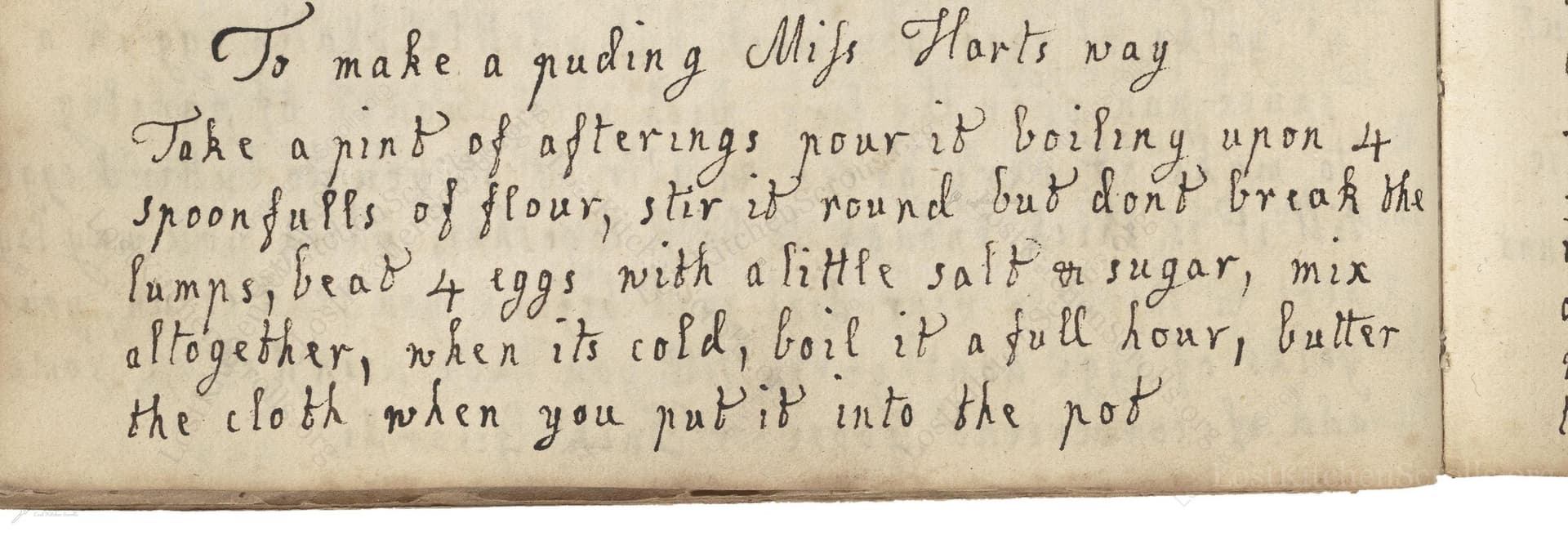To Make A Guding Miss Harts Way
From the treasured pages of Cookbook of 1720
Unknown Author

To Make A Guding Miss Harts Way
"Take a pint of afterings pour it boiling upon 4 spoonfulls of flour, stir it round but don't break the lumps, beat 4 eggs with a little salt or sugar, mix altogether, when its cold, boil it a full hour, butterr the cloth when you put it into the pot"
Note on the Original Text
The recipe is written in a concise, direct style, typical of early 18th-century English manuscript cookery. Quantities are measured in household terms ('spoonfulls', 'pint'), with little instruction on detailed technique—common, as cooks were presumed literate in kitchen practice. Some spelling is archaic or phonetic ('guding' instead of 'guiding' or perhaps a variant of 'gooding'), and note the lack of punctuation, which was normal. Modern cooks benefit from more standardized measurements and directions, as well as clarification on preparation steps.

Title
Cookbook of 1720 (1720)
You can also click the book image above to peruse the original tome
Writer
Unknown
Era
1720
Publisher
Unknown
Background
Step back to the early 18th century and discover a delightful treasury of recipes and culinary secrets, where traditional flavors meet timeless technique—a feast for curious cooks and history lovers alike.
Kindly made available by
Folger Shakespeare Library
This recipe comes from early 18th-century England (circa 1720), a period where everyday puddings were often boiled rather than baked. The use of 'afterings'—the last, richest part of milk after milking—reflects dairy practices before industrial processing, prized for its creamy quality. The recipe's title, 'To make a guding Miss Harts way', hints at a named, likely regional, pudding method. Home cooks of the era frequently shared and recorded friends' or neighbors' preferred receipts in manuscript books, preserving local tastes and techniques.

Back in the 1720s, the cook would have used a large earthenware or metal pot set over an open hearth or range. The pudding mixture was poured into a linen or muslin cloth, thickly buttered to prevent sticking, then tied tightly, often with twine, before being boiled in simmering water. A sturdy spoon for stirring and a bowl for mixing were essential. Eggs would have been hand-beaten, and caution around open flames or embers was part of the daily kitchen routine. Boiling cloth puddings was a tried-and-true method before pudding basins became widespread.
Prep Time
15 mins
Cook Time
1 hr
Servings
6
We've done our best to adapt this historical recipe for modern kitchens, but some details may still need refinement. We warmly welcome feedback from fellow cooks and culinary historians — your insights support the entire community!
Ingredients
- 1 pint (20 fl oz) full-fat milk (or half milk, half double/heavy cream)
- 2 oz plain (all-purpose) flour
- 4 large eggs
- 1/2 teaspoon salt or 1 tablespoon sugar (to taste, optional)
- Butter (for greasing cloth)
Instructions
- To recreate Miss Hart's guiding pudding, begin by bringing 1 pint (20 fl oz) of full-fat milk (or alternately, heavy cream or a mixture of both) to a boil.
- Measure out four heaped tablespoons (about 2 oz) of plain flour into a mixing bowl.
- Pour the boiling milk over the flour, stirring gently—do not overmix; lumps are actually desired for texture.
- Beat four large eggs with a good pinch of salt or about a tablespoon of sugar, depending on your sweet or savory preference.
- When the milk-flour mixture cools, stir in the beaten eggs.
- Pour the mixture into a buttered pudding cloth (a clean cotton/linen tea towel works), tie securely to form a round shape, leaving room for expansion.
- Lower into simmering water and boil steadily for a full hour.
- Remove, untie, and serve warm.
Estimated Calories
250 per serving
Cooking Estimates
Preparing this pudding takes about 15 minutes, including measuring, boiling milk, and mixing. Cooking takes 1 hour, as the pudding must boil steadily to set. Each serving has about 250 calories, and the recipe makes 6 servings.
As noted above, we have made our best effort to translate and adapt this historical recipe for modern kitchens, taking into account ingredients nowadays, cooking techniques, measurements, and so on. However, historical recipes often contain assumptions that require interpretation.
We'd love for anyone to help improve these adaptations. Community contributions are highly welcome. If you have suggestions, corrections, or cooking tips based on your experience with this recipe, please share them below.
Join the Discussion
Rate This Recipe

Den Bockfisch In Einer Fleisch Suppen Zu Kochen
This recipe hails from a German manuscript cookbook compiled in 1696, a time whe...

Die Grieß Nudlen Zumachen
This recipe comes from a rather mysterious manuscript cookbook, penned anonymous...

Ein Boudain
This recipe comes from an anonymous German-language manuscript cookbook from 169...

Ein Gesaltzen Citroni
This recipe, dating from 1696, comes from an extensive anonymous German cookbook...
Browse our complete collection of time-honored recipes



